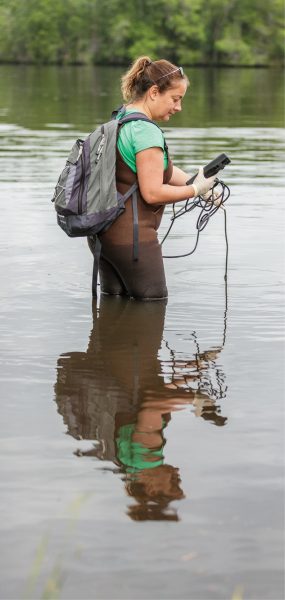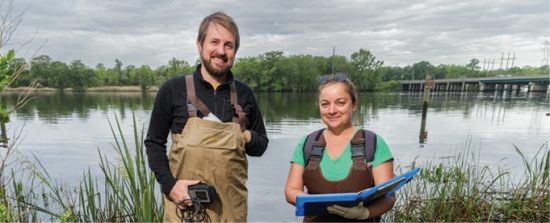Protecting a Priceless Treasure
Asli Aslan Leads New Institute for Water and Health

“As an environmental health scientist, trust me, I have seen the worst in my life,” said Asli Aslan, Ph.D., associate professor in the Jiann-Ping Hsu College of Public Health and director of the new Institute for Water and Health at Georgia Southern.
A water microbiologist with an international reputation, Aslan has spent her career testing water sources around the world for possible contamination.
On a chilly April morning, Aslan and Luke Roberson, a public health doctoral student, waded into the frigid waters of the Ogeechee River at Kings Ferry beach in Savannah, Georgia. Armed with a multiprobe, a device that can measure temperature, conductivity, pH and dissolved oxygen in the water, Roberson tested samples while Aslan, carrying a notebook just above the water, recorded the results.
A popular spot for campers, boaters, skiers and swimmers, Kings Ferry beach had been closed in 2015 for years due to high levels of bacteria in the water from an unknown source. Looking to find a solution, the Georgia Department of Natural Resources (DNR) reached out to Aslan for help.
Using new molecular testing technologies, Aslan and her team took samples around the contaminated site for a year before they found the culprit — a toilet near the park leaking sewage onto the beach.
“DNR investigated the area, fixed the leak, and the next month there was no pollutant,” said Aslan. “Problem solved. Check.”
“I love this part of my job a lot,” she added.
Aslan and Roberson continue to test water samples at Kings Ferry on a regular basis. The project shed a direct light on how human intrusion not only can affect earth’s environment, but also its most precious resource: water. For residents of southeast Georgia — which includes the diverse marshes, swamps, beaches and waterways of the coastal Lowcountry — safe, clean water is essential.
Statesboro and Savannah get much of their fresh water from the Floridan Aquifer, a groundwater system that underlies roughly 100,000 square miles in southern Alabama, southeastern Georgia, southern South Carolina and all of Florida. In addition to Savannah and Statesboro, it provides water for several large cities including Brunswick, Georgia, Jacksonville, Tallahassee, Orlando and St. Petersburg in Florida, as well as hundreds of thousands of people in smaller communities and rural areas.
With record growth happening in much of the southeastern United States, the number of people depending on this vital aquifer will increase exponentially. By 2060, the population of coastal Georgia alone is expected to grow by a million.
“That means there will be more demand for water, which is not an infinite source,” said Aslan.
To respond to these coming challenges and to be a resource for the southeast Georgia region, Georgia Southern created the Institute for Water and Health (IWH). This research and outreach center will work with scientists, government agencies, businesses and industries, nonprofit organizations and communities to create public impact research projects, workforce training for students, and community engagement in water resource management.

“Poor water and health is a planetary problem,” said Aslan. “And here in coastal Georgia, we see many of these problems in different stages, from saltwater intrusion to groundwater sources to aging septic systems that impact our coastal waters like anywhere else in the world.
“As the economy thrives, there will always be a need to balance the health of ecosystems with human demand as our livelihood will depend on these vital resources. As we grow our team here in IWH, a big focus for IWH’s mission in the coming years will be to address issues related to the sustainable use of our water resources.”
The IWH will occupy the former Georgia Bureau of Investigation’s laboratory on Mohawk Street across from the Armstrong Campus in Savannah. Though the 23,000-square-foot lab facility will undergo renovations before the IWH moves in, Aslan and her team are already working on several significant projects.
The first is a $120,000 seed grant funded by the Georgia DNR Environmental Protection Division to create an accessible online water dashboard that will provide public access to current and historical water levels to see how it has changed over time. Aslan says the information will also be important for industries looking to build in southeast Georgia and decision makers who are looking for alternative water resources to meet the demand.
Rapid-response research is one of the areas on which IWH is building its reputation in the region. Aslan and the IWH, along with Risa Cohen, Ph.D., in the College of Science and Mathematics (COSM) and Haresh Rochani, DrPH, in the Jiann-Ping Hsu College of Public Health (JPHCOPH), are working with the Coastal Resources Division of DNR on a rapid-testing method for beach monitoring using qPCR, a protocol that detects specific water pathogens in a matter of hours. Currently, it can take two days or more to determine water quality and safety for beachgoers, but Aslan says this process could lead to same-day reporting so families are informed before they get into the water.
The IWH is also partnering with other faculty at Georgia Southern to come up with ways to manage wastewater more efficiently. With funding from the U.S. Environmental Protection Agency, Aslan is working with Stetson Rowles, Ph.D., and Francisso Cubas, Ph.D., in the Allen E. Paulson College of Engineering and Computing (CEC) to use Georgia Southern’s food waste for improving anaerobic digestion, a wastewater treatment method that uses bacteria to convert hard-to-treat industrial waste into biogas.
“College campuses are one of the most producers of food waste in the nation and using this product to advance wastewater treatment technologies will be a game changer for sustainable water resource management in coastal Georgia,” said Aslan.
She’s also working with Rocio Perez, Ph.D., and Anthony Siccardi, Ph.D., associate professors in COSM to improve wastewater quality. Siccardi is doing research with algal turf scrubbers — turf-lined ramps over which water is pulsed to grow algae, which can remove contaminants and excess nutrients like nitrogen from the water. With Perez, an expert on emerging contaminants, the team has installed an algal turf scrubber at the wastewater treatment plant in Statesboro to test its ability to improve water quality.
“To our knowledge, this is the first time in the nation that an algal turf scrubber is being installed on a wastewater treatment plant in a local community to investigate removing emerging contaminants” said Aslan. “So it’s pretty amazing that we will have data at the source to understand how this technology can improve water quality in receiving waters.”
Aslan says she expects several more projects on the horizon with many other faculty from Georgia Southern. In the meantime, she and her team in the IWH will work to build relationships with nonprofits, other universities and industries, becoming a hub that connects local communities with researchers, educators, students, local governments, and businesses in order to bring more awareness to water conservation and safety.
“What we’re doing day to day right now is building that network,” said Aslan. “As a research center, we also have a strong community engagement component because in coastal Georgia we really need to communicate the risks and the opportunities related to water in our environment, and that needs more attention in the wake of increased migration and climate change.”
Chris Curtis, Ph.D., vice provost for research and scholarship at Georgia Southern, says the IWH is just the first step in the University’s plan to specialize in public impact research areas where the University can make a difference in southeast Georgia. These areas include community enrichment, coastal resilience and sustainability, logistics and supply chain innovation, advanced materials and manufacturing, and holistic fitness and wellness.
“You can think of it in a big way as, ‘What is Georgia Southern particularly good at?’” he said. “We’re trying to elevate the University from just being a really good partner to being a leader of regional development. Economic development is a piece of it, but it’s really more holistic. It’s about the quality of life that we want to bring to southeast Georgia and to the coast.”
The University plans to create more institutes and research centers that will not only bolster Georgia Southern’s reputation in the state and in the nation, but also will make the region a more attractive destination.
“At the end of the day, whether people are thinking about bringing their business to southeast Georgia or whether they’re thinking about bringing their family to southeast Georgia for a job, we want people to say this could be a good place because Georgia Southern is here,” said Curtis.
“That’s the end game.”
— Doy Cave
